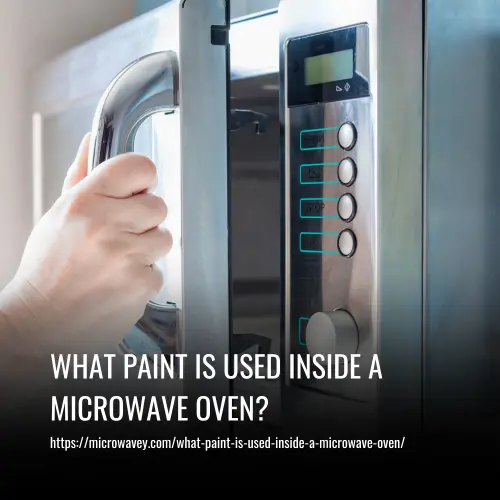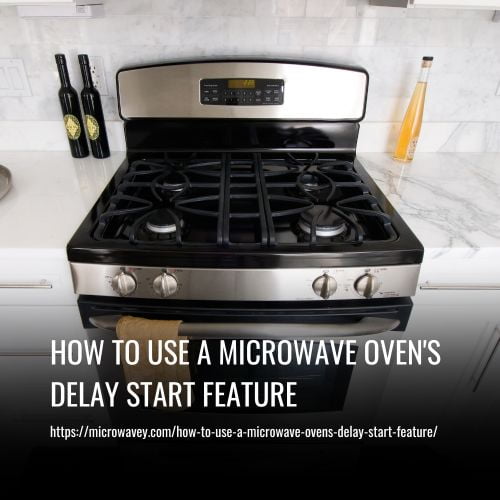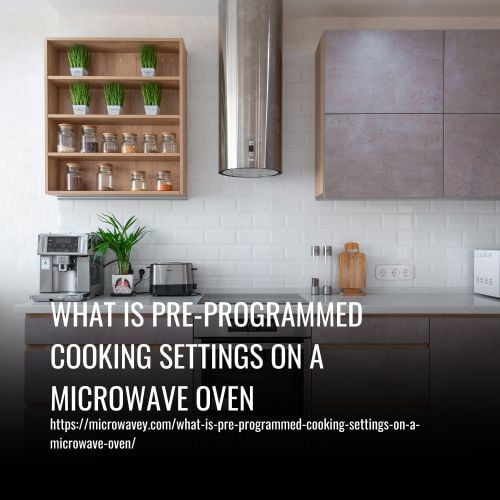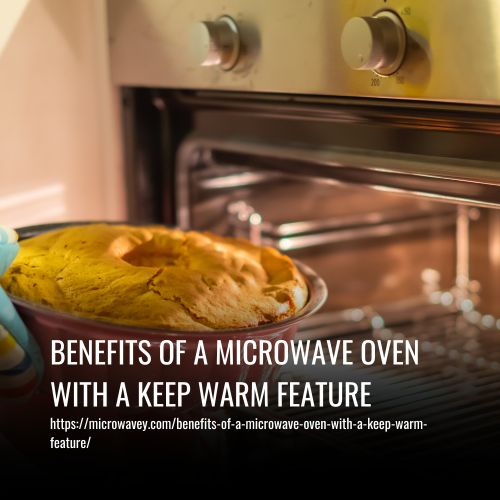How Do You Tell If Your Microwave Is Vented Outside?
To check if your microwave is venting outside, look above, behind, or below the cabinet that your microwave is in for a tube that could send the exhaust outside your house. Also, check directly behind your microwave for another air duct that could be venting the vapors outside. If you don’t already see a duct it’s likely your microwave vents through the top of the front of it.
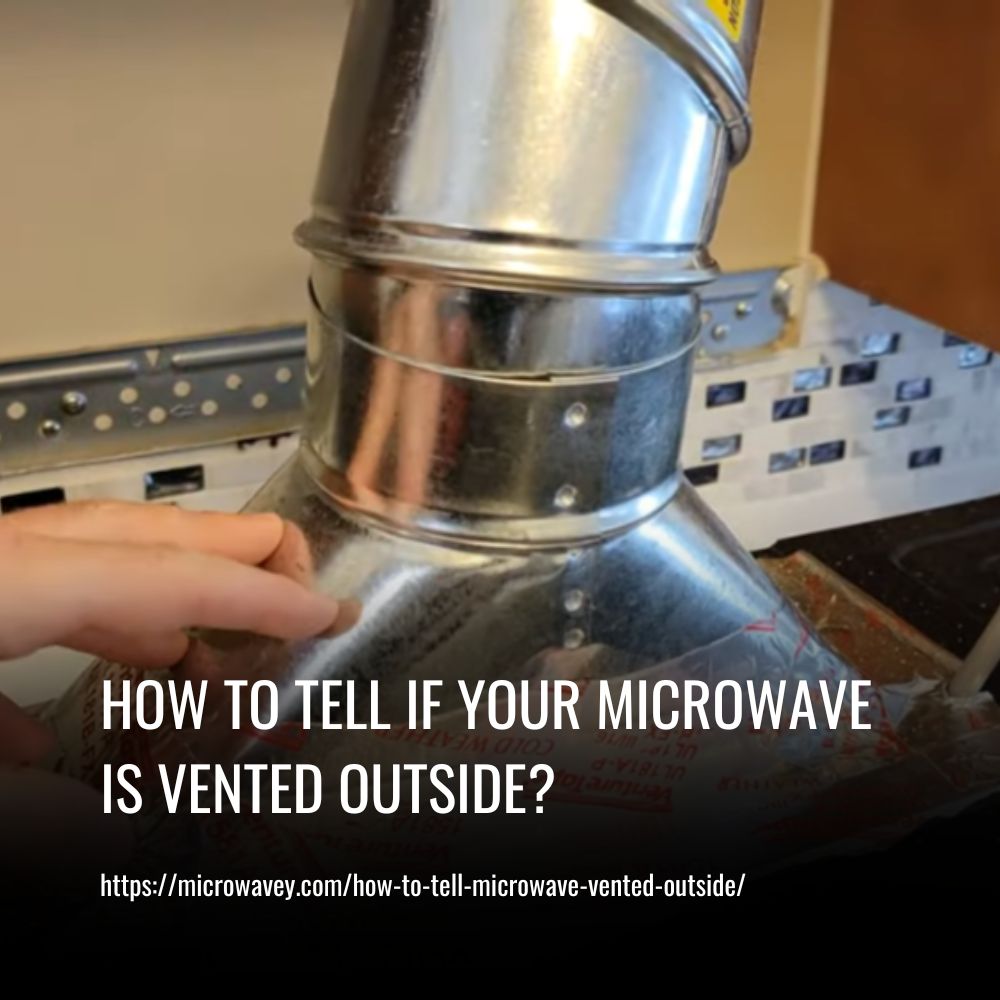
How Do You Tell If Your Microwave Is Vented Outside
Here are some tips to help you determine if your microwave is vented outside:
1. Check the Location of Your Microwave
The first step in determining if your microwave is vented outside is to examine its location. Microwaves that are vented outside are typically installed above the kitchen stove. If your microwave is located in this position, it is more likely to be vented outside.
2. Inspect the Back of Your Microwave
Look for any visible exhaust ducts or venting features at the back of your microwave. Vented microwaves will have an exhaust duct that is connected to an exterior vent. If you see a vent at the back of your microwave, it is an indication that it is vented outside.
3. Look for Venting Options on the Control Panel
Some microwaves have control panel options related to venting. Check if your microwave has settings such as “Exhaust,” “Venting,” or “External Vent.” These options suggest that your microwave is vented outside rather than recirculating the air.
4. Check for External Venting Features
Take a closer look at the exterior of your microwave. Vented microwaves will have external components, such as an exhaust port or vent cover, which are used to expel the air outside. If you find these features, it is a strong indication that your microwave is vented outside.
5. Consider the Age and Model of Your Microwave
Newer models of microwaves are more likely to be designed for external venting as it is a more effective method of ventilation. Older models may not have this feature, so keep the age and model of your microwave in mind when determining if it is vented outside.
6. Consult the Owner’s Manual or Contact the Manufacturer
If you are still unsure whether your microwave is vented outside, refer to the owner’s manual or contact the manufacturer directly. They will be able to provide you with specific information about your microwave model and its venting options.
Venting your microwave outside helps improve air quality and eliminates cooking odors, making your kitchen a more pleasant space to work in.
Do Over-the-Range Microwaves Have to be Vented Outside
Does the microwave you want to install above your stove have to be vented?
No. OTR microwaves do not need to be vented outside. Basically, all microwaves come with venting at the top of the front of the microwave. This is so they work anywhere they are placed. According to GE, Over-the-Range microwaves do not need external venting. So don’t fret about venting your microwave, especially if it is a GE microwave. Many microwaves are recirculating (non-vented ductless).
Signs That Your Microwave is Vented Outside
If you’re uncertain whether your microwave is vented outside, here are a few indicators to help you determine:
- Check the Installation Instructions: Consult the installation manual or paperwork that came with your microwave. It should clearly state whether the unit is designed for external venting or if it is a recirculating vent type.
- Look for an Exhaust Port: Inspect the back or top of your microwave for an exhaust port. If there is a vent or an opening that appears to lead to the outside, it is likely that your microwave is vented outside.
- Examine the Charcoal Filters: Vented microwaves often contain charcoal filters located near the exhaust port. These filters help remove odors and grease from the air before venting it outside. If you see charcoal filters in your microwave, it indicates that it is vented outside.
- Listen for an Exhaust Fan: Turn on your microwave and listen for the sound of an exhaust fan. Microwaves that are vented outside usually have a built-in fan to expel cooking odors and steam. If you hear this fan, it is an indication that your microwave is vented outside.
- Check for External Venting: Look around your kitchen to see if there is an external vent or hood above your stove. Vented microwaves are typically connected to an exhaust duct or vent that leads outside to remove cooking by-products.
Remember, if you are still unsure about whether your microwave is vented outside, it is recommended to consult a professional or refer to the manufacturer’s guidelines.
Why Knowing if Your Microwave is Vented Outside is Important
Knowing if your microwave is vented outside is important for several reasons:
Effective Removal of Cooking By-Products: Microwaves that are vented outside can effectively remove cooking odors, steam, and grease from your kitchen. This helps keep your cooking space clean and fresh, preventing lingering odors and potential grease buildup.
Health and Safety: Proper ventilation is essential for maintaining good indoor air quality. Without proper venting, cooking by-products such as smoke, steam, and grease can accumulate and negatively affect your health. Venting outside helps remove these pollutants, creating a healthier environment for you and your family.
Compliance with Building Codes: Many building codes require that kitchens have proper ventilation systems, including vented microwaves. Knowing if your microwave is vented outside ensures compliance with these codes, avoiding any potential issues during building inspections or when selling your home.
Extended Lifespan: Microwaves that are vented outside tend to have a longer lifespan compared to recirculating vent types. The removal of cooking by-products and grease reduces the strain on the microwave’s internal components, leading to better performance and longevity.
Improved Efficiency: Vented microwaves are more efficient in removing cooking by-products, helping to keep your kitchen clean and reducing the need for excessive cleaning and maintenance. This saves you time and effort in the long run.
It is important to know if your microwave is vented outside for effective odor and grease removal, improved health and safety, compliance with building codes, increased lifespan, and enhanced efficiency in maintaining a clean kitchen environment.
What is a Self-Venting Microwave
A self-venting microwave is a type of microwave oven that is designed to vent cooking by-products, such as steam, smoke, and odors, without the need for external ductwork or vents. It utilizes a built-in vent fan and charcoal filters to recirculate and filter the air within the microwave, removing impurities and releasing cleaner air back into the kitchen.
Self-venting microwaves are convenient for those who don’t have access to external venting options or don’t want to go through the installation process. However, they may not be as effective as vented microwaves in removing all cooking by-products, and the charcoal filters need to be regularly cleaned or replaced to maintain their effectiveness over time.
Where are the Vents on a Microwave
The vents on a microwave are typically located on the back or along the top surface of the appliance. These vents serve an important function in releasing heat generated during cooking and preventing the buildup of steam and cooking odors inside the microwave.
However, not all microwaves are vented outside. Some microwaves come with an internal recirculating vent system that filters the air and releases it back into the kitchen. If your microwave has an exhaust duct or a vent fan, it is likely vented outside.
You can check the installation instructions or consult a professional to determine if your microwave is vented outside or if additional ductwork is required.
Clearance Requirements for Ventilation
Checking if your microwave is vented outside is important for proper ventilation and to avoid recirculating cooking odors and grease in your kitchen. Here’s how to determine if your microwave is properly vented:
1. Check for an Exhaust Port
Look on the top, back, or bottom of your microwave for a visible exhaust port. This is where the vent fan blows out air when the microwave is in use. If it is present, your microwave is likely vented outside.
2. Inspect the Exterior Components
If your microwave has an external vent, you should see a hood or vent cover on the outside of your home near the kitchen. This is where the exhaust air is released. Make sure the vent cover is in good condition and free from obstructions.
3. Review the Installation Instructions
Examine the microwave’s installation manual to determine whether external venting is an available option. It should outline the steps for vent installation and any necessary ductwork.
4. Consult Building Codes
Local building codes may dictate specific requirements for venting microwaves. Confirm that your microwave installation complies with these standards to ensure proper ventilation.
Remember, not all microwaves are vented outside. Some models use charcoal filters to trap cooking by-products and recirculate the air back into the kitchen. If you are unable to determine if your microwave is vented outside, consult the owner’s manual or contact the manufacturer for guidance.
FAQs
It is generally not recommended to install a vented microwave in a cabinet. Vented (or over-the-range) microwaves are designed to be installed above a stove or cooktop and require proper ventilation to remove cooking odors, steam, and grease. Installing a vented microwave in a cabinet can cause heat buildup and potentially damage the microwave or the cabinet itself.
Yes, LG microwaves can be vented outside. Most LG over-the-range microwaves are designed to be vented outside to effectively remove cooking odors, grease, and smoke from your kitchen. To determine if your LG microwave is vented outside, check the installation instructions provided with the appliance.
Microwave vents do not typically get hot. The purpose of the vent is to exhaust cooking by-products, such as steam, odors, and grease, to the outside of the microwave. While the vent fan motor may produce some heat during operation, the vent itself is designed to be cool to the touch.
The vent button on a microwave is used to control the ventilation system of the appliance. When the vent button is pressed, the microwave’s fan will turn on, pulling in air from the cooking space and expelling it outside through a vent or exhaust duct. This helps to remove cooking odors, smoke, steam, and grease from the kitchen.
To ensure proper airflow and protect the microwave, it is recommended to provide a clearance of 3 inches at the top and sides of the microwave, with at least 1 inch at the rear. This space allows for adequate ventilation and prevents overheating of the appliance. It is important to follow these clearance guidelines to maintain the optimal performance of your microwave.
The size of the microwave vent depends on the specific model and manufacturer. Generally, a 3 1/4″ x 10″ (8.3 cm x 25.4 cm) rectangular or a 6″ (15.2 cm) round vent is used. It is essential to follow the manufacturer’s guidelines for vent installation to ensure proper operation and safety. Moreover, the total length of the vent system, including straight vents, elbows, transitions, and wall or roof caps, should not exceed the equivalent of 140 ft (42.7 m) for either type of vent.
Yes, most OTR microwaves are equipped with built-in thermostat-controlled vent fans. These vent fans turn on automatically if the unit becomes too hot and will not turn off until the microwave cools down again. This helps to protect the microwave and ensure proper ventilation during heavy usage.
It is not a requirement that an OTR microwave should be vented outside. While some homeowners prefer venting the microwave outside to eliminate cooking odors and remove grease, it is not necessary. If you are not dealing with smoke or harmful fumes, recirculating the air into your kitchen or elsewhere is perfectly fine.
Microwaves are a common kitchen appliance used for heating and cooking food quickly. When it comes to Over-the-Range (OTR) microwaves, there is often confusion about whether they are vented outside or not. Here are some important points to consider to determine if your microwave is vented outside.
To check if your microwave vent is working properly, you can perform a simple test. Turn the vent fan on its highest setting and hold a tissue or paper towel under the vent area. If the vent is working effectively, it should create sufficient suction to hold the tissue or paper towel in place.
The strength of the draw should be equal on both sides of the vent, indicating a balanced airflow. If the tissue or paper towel does not stay in place or the suction is weak, it may be an indication that the venting system needs to be inspected or repaired.
No, not all microwaves vent on top. The venting mechanism of a microwave depends on its model and type. Some over-the-range microwaves are designed to vent kitchen air outside by using an exhaust fan that expels the air through ductwork in the wall.
Others utilize a charcoal filter to recirculate the air back into the kitchen after trapping and filtering out cooking odors and grease. There are also models available that can operate both as externally vented and recirculating vent microwaves, providing more flexibility in ventilation options.
If a microwave is not properly vented, it can lead to several issues. Without adequate ventilation, the microwave can overheat, which can cause damage to its internal components and potentially lead to a fire hazard.
Additionally, the lack of proper venting can result in the accumulation of cooking by-products, such as grease and smoke, in the kitchen, leading to unpleasant odors and poor indoor air quality. It is important to ensure that your microwave is properly vented to prevent these potential problems.
An externally vented microwave is a type of microwave oven that has the capability to send cooking by-products, such as smoke and odors, outside through an exhaust vent. This type of ventilation system operates by using an exhaust fan to draw air from the cooking space and expel it through a duct that connects to an exterior vent on the wall or roof.
Conclusion
In conclusion, determining whether your microwave is vented outside or not is crucial for ensuring proper ventilation and avoiding potential hazards. By following the steps outlined in this article, you can easily determine if your microwave is vented outside or if it recirculates air back into the kitchen.
Remember to check for external vents, inspect the microwave’s installation manual, and listen for the sound of air being expelled. If you are unsure or unable to determine the venting mechanism, it is always best to consult a professional.
Taking the time to assess and understand your microwave’s venting system will contribute to a safer and more efficient kitchen environment.

